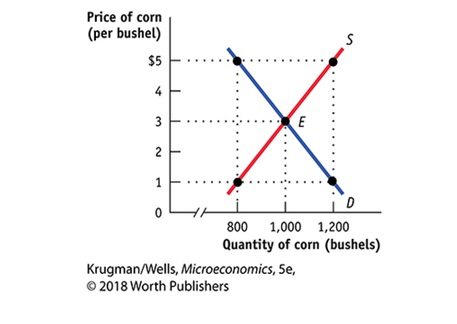
(Based on the diagram):
For the last 80 years the U.S government has used price supports to provide income assistant to American farmers. To implement these price supports, at times the government has used price floors, which it maintains by buying up the surplus farm products. At other times, it has used target price, a policy by which the government gives the farmer an amount equal to the difference between the market price and the target price for each unit sold. Consider the market for corn depicted in the accompanying diagram.

- When the government sets a
floor price of $5 per bushel of corn, the number of bushels of corn produced, the number of bushels the consumers purchase, the amount the government purchases, the cost of the program to the government and the revenue earned by the farmers. - If the government sets a target price of $5 per bushels for any quantity up to 1,000 bushels, the number of bushels the consumers will buy and the price, the number of bushels the government will purchase, the cost of the program to the government and the revenue earned by the farmers.
- The program, in which the price of corn is more to the consumers and the program where the cost is more to the government.
- Explain whether one of these policies less inefficient than the other
Concept Introduction:
Floor Price:
It is a government-imposed price control or limits on the minimum price that can be charged for a product. A floor price must be higher than the market price to be effective.
Target Price:
A policy where the government pays the farmers an amount equal to the difference between the market price and the target price for each unit of the output sold.
Deadweight loss can be stated as the loss of total surplus due to taxes or subsidies,
Want to see the full answer?
Check out a sample textbook solution

 Principles of Economics (12th Edition)EconomicsISBN:9780134078779Author:Karl E. Case, Ray C. Fair, Sharon E. OsterPublisher:PEARSON
Principles of Economics (12th Edition)EconomicsISBN:9780134078779Author:Karl E. Case, Ray C. Fair, Sharon E. OsterPublisher:PEARSON Engineering Economy (17th Edition)EconomicsISBN:9780134870069Author:William G. Sullivan, Elin M. Wicks, C. Patrick KoellingPublisher:PEARSON
Engineering Economy (17th Edition)EconomicsISBN:9780134870069Author:William G. Sullivan, Elin M. Wicks, C. Patrick KoellingPublisher:PEARSON Principles of Economics (MindTap Course List)EconomicsISBN:9781305585126Author:N. Gregory MankiwPublisher:Cengage Learning
Principles of Economics (MindTap Course List)EconomicsISBN:9781305585126Author:N. Gregory MankiwPublisher:Cengage Learning Managerial Economics: A Problem Solving ApproachEconomicsISBN:9781337106665Author:Luke M. Froeb, Brian T. McCann, Michael R. Ward, Mike ShorPublisher:Cengage Learning
Managerial Economics: A Problem Solving ApproachEconomicsISBN:9781337106665Author:Luke M. Froeb, Brian T. McCann, Michael R. Ward, Mike ShorPublisher:Cengage Learning Managerial Economics & Business Strategy (Mcgraw-...EconomicsISBN:9781259290619Author:Michael Baye, Jeff PrincePublisher:McGraw-Hill Education
Managerial Economics & Business Strategy (Mcgraw-...EconomicsISBN:9781259290619Author:Michael Baye, Jeff PrincePublisher:McGraw-Hill Education





